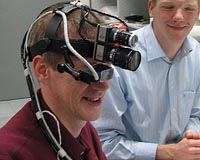 |
Hawthorne CA (SPX) Sep 25, 2009 We are now only a few months away from having the inaugural Falcon 9 launch vehicle on its launch pad at Cape Canaveral and ready to fly! The actual launch date will depend on a variety of factors, including weather and the overall launch schedule at the Cape, so that is a little harder to predict. Based on prior experience, launch could be anywhere from one to three months after Falcon 9 is integrated at the Cape in November. This initial test flight will carry our Dragon spacecraft qualification unit, providing us with valuable aerodynamic and performance data for the Falcon 9 configuration that will fly on the following COTS and CRS missions for NASA. The second Falcon 9 flight will be the first flight of Dragon under the NASA COTS (Commercial Orbital Transportation Services) program, where we will demonstrate Dragon's orbital maneuvering, communication and reentry capabilities. Though it will initially be used to transport cargo, the Dragon spacecraft was designed from the beginning to transport crew. Almost all the necessary launch vehicle and spacecraft systems employed in the cargo version of Dragon will also be employed in the crew version of Dragon. As such, Dragon's first cargo missions will provide valuable flight data that will be used in preparation for future crewed flight. This allows for a very aggressive development timeline-approximately three years from the time funding is provided to go from cargo to crew. The three year timeframe is driven by development of the launch escape system. This includes 18 months to complete development and qualification of the escape engine, in parallel with structures design, guidance, navigation and control, and supporting subsystems. Another 12 months will be required to perform various pad and flight abort tests, which are slated to take place at NASA Goddard Space Flight Center's Wallops Flight Facility (Virginia). Under this timeline, the first crew launch would take place 30 months from the receipt of funding, leaving six months of schedule margin to allow for the unexpected.
Dragoneye DragonEye launched aboard the Space Shuttle Endeavour on July 15th, 2009 and tested successfully in proximity of the ISS (photos below). DragonEye provides three-dimensional images based on the amount of time it takes for a single laser pulse from the sensor to the reach a target and bounce back, providing range and bearing information from the Dragon spacecraft to the ISS.
Dragon Parachute Load Testing
FALCON 9 - First Stage Engines Together, the nine Merlin engines produce over 1 million pounds of thrust, and consume over half a million pounds of fuel and oxidizer in just under three minutes as they push the Falcon 9 out of Earth's atmosphere and into orbit.
Second Stage Engines
Structures The entire system was assembled and checked out in our Hawthorne facility, and then shipped to Texas for integration with the first stage propellant tanks, which recently completed proof and leak testing there. The F9 second stage has been shipped to Texas and is being prepped for structural testing which will begin this week, followed closely by stage separation testing. Elsewhere in our Hawthorne plant, the launch vehicle for the second Falcon 9 flight is well underway. On the Friction Stir Welding (FSW) machine (above), the first stage tank passed the mid-point with the completion of the fuel tank welding. Additional barrel sections and one more dome will complete the LOX tank. The primary tank structure for the second flight's second stage has already been fabricated and is being processed next to the second stage for the first flight. Note that the first and second stages use a common architecture such as the same 3.7 meter (12 foot) diameter aluminum-lithium barrels and domes, and we manufacture them utilizing the same systems and tooling. This approach greatly reduces overhead, inventory and production costs, and simultaneously contributes to increased reliability. These are essential aspects of how SpaceX improves reliability and lowers the cost of access to space.
Avionics
Launch Operations And we are finishing up numerous other systems that support safe and efficient launch operations. Other vital systems now in process include support for the storage and handling of RP-1 fuel, as well as nitrogen, helium, and the water deluge systems that help protect the pad and vehicle from the significant levels of thermal and acoustic energy created during launch. Share This Article With Planet Earth
Related Links SpaceX Space Tourism, Space Transport and Space Exploration News
 Augmented Reality To Help Astronauts Make Sense Of Space
Augmented Reality To Help Astronauts Make Sense Of SpaceParis, France (ESA) Sep 24, 2009 Life aboard the International Space Station is hard work. Crewmembers have a multiplicity of complex tasks, potentially involving thousands of tools, components and other items. But ESA astronaut Frank De Winne has begun testing the prototype of an unusual helper designed to make astronaut life easier. The ESA-designed Wearable Augmented Reality (WEAR) is a wearable computer system that in ... read more |
|
| The content herein, unless otherwise known to be public domain, are Copyright 1995-2009 - SpaceDaily. AFP and UPI Wire Stories are copyright Agence France-Presse and United Press International. ESA Portal Reports are copyright European Space Agency. All NASA sourced material is public domain. Additional copyrights may apply in whole or part to other bona fide parties. Advertising does not imply endorsement,agreement or approval of any opinions, statements or information provided by SpaceDaily on any Web page published or hosted by SpaceDaily. Privacy Statement |